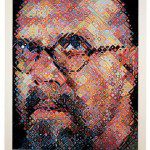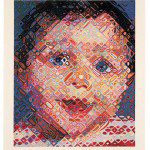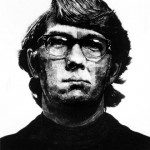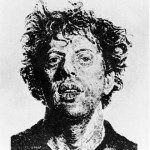Chuck Close at the Corcoran
By • July 26, 2011 0 1589
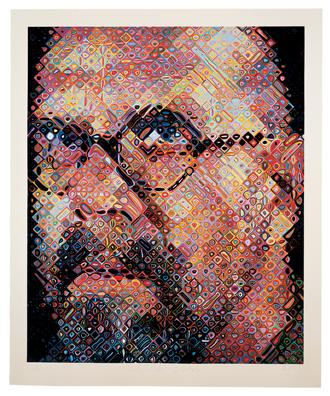
In the jumbled lexicon of late 20th century fine arts, where endless styles and genres collapse into one another like a landscape of staggered dominos, few artistic voices have emerged with any lasting force. Chuck Close is one of the few. Famous for his large-scale portraits ranging in medium from painting and drawing to printmaking and photography, Close’s work has a mystifying staying power that attracts audiences with its grandiosity and astounding depth. “Chuck Close Prints: Process and Collaboration,” a retrospective at the Corcoran Gallery of Art, is perhaps the seminal exhibition of Close’s work — an immense yet intimate ode to the timeless appeal of portraiture and the boundless expanses of Close’s technical innovations in art.
Close’s colossal, hyper-realistic portraiture is as synonymous with his name as Jackson Pollock’s is with drip painting. He is one of a handful of working artists that can draw crowds well beyond artistic communities, and has played a large hand in reviving interest and relevance in realism after a tidal wave of artistic deconstruction and abstraction. His techniques have been groundbreaking, and the steady evolution of his work demands to be experienced.
The exhibition offers far more than a comprehensive collection of Close’s work. It delves further, inviting the viewer into his artistic process, which is in large part the source behind the awe his work inspires. “I think people can look at his work and understand what they’re looking at, but also be fascinated … and not quite understand how he’s managed to make the works that he’s made,” says Amanda Maddox, organizing curator of the exhibition. Thus, the show aims to help the audience understand Close’s work through his process.
Focused largely on his extensive body of prints, the show examines Close’s revisiting of printmaking in his visual experimentation. Ultimately, these experiments have resulted not only in some of Close’s most accomplished works, but new techniques and approaches that have greatly expanded the possibilities of the medium.
A piece in this show rarely just stands alone. Displayed is the geography of artistic process, a roadmap of studies leading up to a final image. Alongside his lithograph prints hang the actual lithographs used in the printing, with descriptions of his techniques and technical hurdles. The show displays the original grids that preceded each work, parchment rolls of matrices and proofs covered in scrawling notes by the artist. Color charts and value studies map the topography of Close’s artistic journey, a technical mastery wrought by compulsion and relentless experimentation. In a way, the show becomes a discussion of artistic tribulations, limitations, triumphs and revelations.
As a student, Close was primarily interested in abstract painting, claiming to have been something of a diluted, amateur Willem de Kooning, a painter he greatly admired. However, in 1967, he decided to abandon abstraction and turned his attention toward monumental, hyper-realistic portraits of himself, family and close friends.
He then took it a step further, abandoning the paintbrush for printmaking, a medium in which he had no expertise or facility, in order to challenge himself. His intention was to force a creative breakthrough. In 1972, with the help of printer Kathan Brown, Close created his first print, revisiting the archaic 17th century printing technique of mezzotint, the first printing technique to utilize halftones. The print, titled “Keith/Mezzotint” — displayed upon entering the exhibition — is an intricate study in halftones and textures, light and dark, producing a modern, layered effect while maintaining an astounding technical realism. This melding of photorealism inside abstract textures and patterns has become a trademark of Close’s work.
Over his career, and with the assistance of master printers and various collaborators, Close has created some of the most memorable images of the last 40 years. When making a print, Close and his team complete every stage of their process by hand, from translating an image onto a matrix to carving wood blocks, etching plates, and applying multiple layers of color. The sheer scale and technical complexity of his portraits, combined with this time-consuming process, often means that a single print can take years to complete. However, Close welcomes this challenge. “When you have very strict limitations,” he says, “you have to be … very creative to figure out a way of getting them to work for you. I found that kind of problem-solving very interesting.”
Much of the genius of Close’s work comes from the two contrasting views afforded to the onlooker in each piece — the audience must look at each work twice. From afar the portraits, while differing in tonal value and color pattern, range in appearance from photorealistic to a stylized, almost digitally altered realism. The way in which Close works from photographs dissected into grid, or incremental units, as he calls them, ensures that all his work will be anatomically accurate and perfectly balanced in reality, whether it is made with pulp paper multiples or his own fingerprints.
But the closer one moves in towards a piece, the more it begins to break up, until, inches from the paper, there is nothing to be seen but a kaleidoscopic field of colors and shapes and textures – a very real abstraction. As Maddox explains, “He’s interested in how much information you can convey or compact into a space, and then translate.”
In this regard, it really is the scale that mesmerizes. Reproductions of Close’s work fail to capture their essences much in the same way that Lichtenstein’s large-scale comic strip paintings, when shrunk onto paper, merely look like an excerpt from a comic. The shrunken copies, as the ones accompanying this article, are merely a shadow of the actual works, which are often more than six feet tall.
“I think the show presents an opportunity to really see his marks, and see how detailed his work is,” says Maddox. “Chuck is interested in scale and the destabilizing effect that scale can produce or impart. I think people find that fascinating more than anything else.”
The sheer nature of the realism and the quirks of his techniques cannot be understood unless experienced. His process is engaging, and the variations are remarkable. From traditional Japanese ukiyo-e woodblock prints to silkscreen, aquatint, and spitbite etching, his repertoire of printing techniques is a history lesson in itself, and the subtle, palpable printing methods are only comprehensible when viewed from inches away — an unusual and welcome intimacy for such grandiose work.
The exhibition has been touring domestically and internationally over the last seven years. Running through Labor Day weekend at the Corcoran, “Chuck Close Prints: Process and Collaboration” is one of D.C.’s finest offerings this season. It is a piece of history as it is being told, and an open-ended invitation into the mind of a modern artistic genius. More than any show most will ever see, the exhibition illuminates the agonies and ecstasies of the artistic process as it is usually only experienced by art historians, curators and restorers.
The Corcoran has additionally made itself free to the public on Saturdays through Labor Day weekend this year. There is no reason to miss this groundbreaking collection and experience the corridors of details, the overwhelming scale, and the fragile intimacy of Chuck Close.
Contact the author at ari@georgetowner.com.
- “Self Portrait,” silk screen, 2000 | Courtesy Corcoran Gallery of Art

